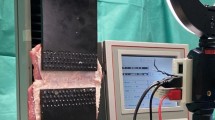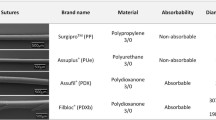Abstract
The aim of the present study was to assess two methods of mass abdominal closure with the fishing line as an alternative suture material for abdominal wall closure. Eighteen healthy male white rabbits weighing approximately 2.5 kg were used in this study. Animals were separated into three groups: control group (CG) (n = 06), interrupted pattern suture experimental group (IEG) (n = 06), and continuous pattern suture experimental group (CEG) (n = 06). Incisional wounds (4 cm) were performed in the right flank of abdominal wall. In control group (CG), the abdominal muscles and peritoneum were sutured in one layer with simple interrupted pattern using PGA resorbable suture and the skin with commercial synthetic suture (nylon). Then, in experimental groups, closure of peritoneum, abdominal muscles, and skin was performed with one-layer pattern using translucent nylon fishing line. Daily scores were allocated for signs of infection, wound healing, and wound adhesion. A faster wound closure time was recorded in control group (9 days) compared to experimental groups (13 days). All study animals showed low adhesion scores that were very important in the muscular wall. Almost similar histopathology profiles were observed in all groups. This study has demonstrated that fishing line, as suture material, is suitable for mass abdominal closure in rabbit model.








Similar content being viewed by others
References
Abramov Y, Golden B, Sullivan M, Botros SM, Miller JJR, Alshahrour A, Goldberg RP, Sand PK (2007) Histologic characterization of vaginal vs. abdominal surgical wound healing in a rabbit model. Wound Repair Regen 15:80–86
Alshehabat MA, Bani Ismail ZA, Hananeh WM, Awawdeh MS (2016) Effect of Sidr honey on healing of contaminated wounds in alloxan-induced diabetes mellitus in dogs Res Opin Anim Vet Sci 6
Batista CAM, Colleoni Neto R, Lopes Filho GDJ (2008) Comparative study of the healing process of the aponeurosis of the anterior abdominal wall of rats after wound closure using 3-0 nylon suture and N-butil-2-cyanoacrylate tissue adhesive. Acta Cir Bras 23:352–363
Ceydeli A, Rucinski J, Wise L (2005) Finding the best abdominal closure: an evidence-based review of the literature. Curr Surg 62:220–225
Chellamani K, Veerasubramanian D, Balaji R (2013) Surgical sutures: an overview. J Acad Ind Res 1:778–782
Coulter CA, Flecknell PA, Leach MC, Richardson CA (2011) Reported analgesic administration to rabbits undergoing experimental surgical procedures. BMC Vet Res 7:12
Cox I (2004) Guidelines for re-sterilising sutures. Community Eye Health 17:30
Ergul E, Korukluoglu B (2008) Peritoneal adhesions: facing the enemy. Int J Surg 6:253–260
Freudenberg S, Mkony C, Wilhelm T, Nyawawa T, Kuhn C, Grobholz R, Post S (2004a) Atraumatic intracutaneous skin closure with self-made fishing line suture compared to commercial thread. East Afr Med J 81:348–352
Freudenberg S, Nyonde M, Mkony C, Bay F, Wilhelm T, Post S (2004b) Fishing line suture: cost-saving alternative for atraumatic intracutaneous skin closure—randomized clinical trial in Rwanda. World J Surg 28:421–424
Gupta A, Kumar P (2015) Assessment of the histological state of the healing wound. Plastic Aesthetic Res 2:239–239
Gupta H, Srivastava A, Menon GR, Agrawal CS, Chumber S, Kumar S (2008) Comparison of interrupted versus continuous closure in abdominal wound repair: a meta-analysis of 23 trials. Asian Journal of Surgery 31:104–114
Hendrickson DA, Baird AN (2013) Turner and McIlwraith’s techniques in large animal surgery. John Wiley & Sons
Köm M (2013) Effect of hyaluronic acid/carboxymethylcellulose and flunixin meglumine combination on the prevention of postoperative intraabdominal adhesions: an experimental study in rabbits Kafkas Universitesi Veteriner Fakultesi Dergisi 19
Kudur MH, Pai SB, Sripathi H, Prabhu S (2009) Sutures and suturing techniques in skin closure. Indian J Dermatol Venereol Leprol 75:425
Lauder CI, Garcea G, Strickland A, Maddern GJ (2010) Abdominal adhesion prevention: still a sticky subject. Dig Surg 27:347–358
Lemo N, Marignac G, Reyes-Gomez E, Lilin T, Crosaz O, Dohan Ehrenfest DM (2010) Cutaneous reepithelialization and wound contraction after skin biopsies in rabbits: a mathematical model for healing and remodelling index. Veterinarski arhiv 80:637–652
Longombe AO, Ralaimiarison A, Lusi K (1993) The use of fishing Nylon for surgery in rural areas in north east Zaire. Trop Dr 23:179–180
Moffatt C (2005) Identifying criteria for wound infection European Wound Management Association (EWMA) Position document: Identifying criteria for wound infection. MEP Ltd, London
Quesenberry KE, Carpenter JW (2004) Ferrets, rabbits, and rodents: clinical medicine and surgery. Saunders Philadelphia,
Rahman MM, Azad AS, Mawla MG, Alam MM, Rahman MM (2014) Outcome of abdominal wound closure following continuous and interrupted suture in elective laparotomy. Faridpur Med College J 8:73–76
Sessler DI (2006) Non-pharmacologic prevention of surgical wound infection. Anesthesiol Clin North Am 24:279–297
Stokes E, Flecknell P, Richardson C (2009) Reported analgesic and anaesthetic administration to rodents undergoing experimental surgical procedures. Lab Anim 43:149–154
Turner AS, McIlwraith CW (1989) Techniques in large animal surgery. vol Ed. 2. Lea & Febiger
Wilson A, Weavill C, Burridge J, Kelsey M (1990) The use of the wound scoring method ‘ASEPSIS’in postoperative wound surveillance. J Hosp Infect 16:297–309
Yavuzer R, Tascilar Ö, Tekin E, Latifoğlu O, Akyol G, Dursun A, Taneri F (1997) Incisional healing in rats treated with diethyl maleate. Eur J Plast Surg 20:306–309
Author information
Authors and Affiliations
Corresponding author
Ethics declarations
Ethical approval
All applicable international, national, and/or institutional guidelines for the care and use of animals were followed.
Conflict of interest
The authors declare that they have no conflict of interest.
Informed consent
Informed consent was obtained from all individual participants included in the study.
Rights and permissions
About this article
Cite this article
Hemida, H., Benchohra, M., Amara, K. et al. Assessment of two abdominal mass closure methods using fishing line in rabbit model: clinical and pathological study. Comp Clin Pathol 27, 821–827 (2018). https://doi.org/10.1007/s00580-018-2667-8
Received:
Accepted:
Published:
Issue Date:
DOI: https://doi.org/10.1007/s00580-018-2667-8




